|
 |
Caspar van Wittel
|
|
(born Caspar Adriaensz. van Wittel, later a.k.a. Gaspare Vanvitelli, Gasparo degli Occhiali) (1653 - September 13, 1736) was a Dutch Golden Age landscape painter.
Van Wittel was born in Amersfoort. He learned painting first from Thomas Jansz van Veenendaal for 4 or 5 years and then from Matthias Withoos for 7 years, until Withoos left Amersfoort. In Amersfoort, he likely was exposed to Dutch landscape artists such as Jan van der Heyden and Gerrit Berckheyde. His first extant works were made in Hoorn in 1672, but he relocated to Rome with his family ca. 1675 and made his career there. Like his former teacher, he joined the Bentvueghels with the nickname "Piktoors" or "Toorts van Amersfoort"(torch of Amersfort).
He married in Rome in 1697, and stayed most of his life in that city, though, between 1694 and 1710, he toured Italy and painted in places like Florence, Bologna, Ferrara, Venice, Milan, Piacenza and Naples. He is one of the principal painters of topographical views known as vedute.
Gaspar van Wittel died in Rome. His son Luigi would become a famous architect and also carries the italianized family name of Vanvitelli.
In Luigi's biography is written that his father was born in July 1656, but Van Wittel's grave in Rome states that he died at the age of 83 in 1736.
|
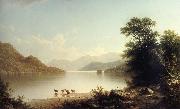 |
Casilear John William
|
|
American Hudson River School Painter, 1811-1893
was an American landscape artist belonging to the Hudson River School. Casilear was born in New York City. His first professional training was under prominent New York engraver Peter Maverick in the 1820s, then with Asher Durand, himself an engraver at the time. Casilear and Durand became friends, and both worked as engravers in New York through the 1830s. By the middle 1830s Durand had become interested in landscape painting through his friendship with Thomas Cole. Durand, in turn, drew Casilear's attention to painting. By 1840 Casilear's interest in art was sufficiently strong to accompany Durand, John Frederick Kensett, and artist Thomas P. Rossiter on a European trip during which they sketched scenes, visited art museums, and fostered their interest in painting. Casilear gradually developed his talent in landscape art, painting in the style that was later to become known as the Hudson River School. By the middle 1850s he had entirely ceased his engraving career in favor of painting full-time. He was elected a full member of the National Academy of Design in 1851, having been an associate member since 1831 |
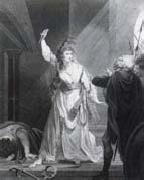 |
Caroline Watson
|
|
British 1760-1814,Daughter of James Watson. In 1780 she signed a stipple print of Isaac Watts and was soon employed by John Boydell (e.g. Prince William of Gloucester, 1784, after Joshua Reynolds). In 1785 she became Engraver to Queen Charlotte (1744-1818), a keen print collector. She was particularly fitted to working after miniatures, such was the delicacy of her engraving, and some of her best prints are portraits and small subjects after Samuel Shelley (c. 1750-1808). She did private commissions of this kind, notably for the Bute family, and also engraved large plates, some for the Boydell Shakespeare Gallery, including the Death of Cardinal Beaufort (1792) after Reynolds, allegedly at his request. She was employed by William Hayley (1745-1820) on his Life of George Romney Esq (London, 1809), and the correspondence involved shows her as a reliable and respected professional. |
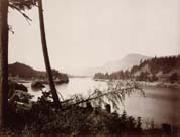 |
Carleton E.Watkins
|
|
American photographers , b. 1829, d. 1916
was a noted 19th century California photographer. Carleton Emmons Watkins was born in Oneonta, upstate New York. He went to San Francisco during the gold rush, arriving in 1851. He traveled to California with Oneontan Collis Huntington, who later became one of the owners of the Central Pacific Railroad, which helped Watkins later in his career. His interest in photography started as an aide in a San Francisco portrait studio, and started taking photographs of his own in 1861. He became interested in landscape photography and soon started making photographs of California mining scenes and of Yosemite Valley. He experimented with several new photographic techniques, and eventually favored his "Mammoth Camera," which used large glass plate negatives, and a stereographic camera. He became famous for his series of photographs and historic stereoviews of Yosemite Valley in the 1860s, and also created a variety images of California and Oregon in the 1870s and later. Watkins purchased the 1860s Central Pacific Railroad construction stereoview negatives from CPRR official photographer Alfred A. Hart and continued their publication through the 1870s. However Watkins was not a good businessman. He spent lavishly on his San Francisco studio and went deeply in debt. His photographs were auctioned, following a business setback, resulting in his photographs being published without credit by I. W. Taber, the new owner. Watkins also had problems of his photographs being reprinted without permission by Eastern companies and with other photographers rephotographing the exact scenes Watkins photographed. In 1879, Watkins married his 22-year-old assistant, Frances Sneade, with whom he had two children. Watkins began anew with his "New Series," which included a variety of subjects and formats, mostly related to California. |
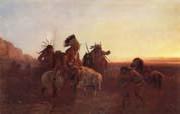 |
Carl Wimar
|
|
1828 - 1862,American painter and photographer of German birth. He arrived in St Louis in 1843. From 1846 to 1850 he studied painting under the St Louis artist Leon de Pomarede (1807-92). In 1852 he continued his studies at the Kunstakademie in Desseldorf, where he worked with Josef Fay (1813-75) and Emanuel Gottlieb Leutze until about 1856. In 1858, having once more based himself in St Louis, he travelled up the Mississippi in order to draw and photograph Indians. Wimar joined a party of the American Fur Trading Company and made several journeys between 1858 and 1860 up the Mississippi, Missouri and Yellowstone rivers in search of Indian subjects. His painting, the Buffalo Hunt (1860; St Louis, MO, Washington U., Gal. A.), became one of the original works in the collection of the Western Academy of Art. In 1861 Wimar was commissioned to decorate the rotunda of the St Louis Court-house with scenes of the settlement of the West. |
 |
Carl Wilhelmson
|
|
1866-1928
Swedish painter and lithographer. Wilhelmson trained first as a commercial lithographer in Göteborg. In 1886 he enrolled as a student of decorative painting at Valand College of Art where his teacher was Carl (Olof) Larsson. In 1888, having obtained a travel grant, he went to Leipzig to study lithographic technique. From 1890 to 1896 he lived in Paris, where he worked as a lithographer and commercial artist and studied at the Academie Julian. Wilhelmson's preferred subject-matter was the coastal landscape of Bohuslen and the people of its little fishing villages with their huddles of wooden houses. There is no trace of ethnography in his depictions of local life; they are full of serious realism and display a sensitive insight into the perilous life of the fishermen, with which he had been familiar since childhood. In the Village Shop |
 |
Carl Wilhelm Barth
|
|
(1847 - 1919) was a Norwegian painter.
He was born in Christiania. He studied painting under Hans Gude from 1881 to 1883, and having worked as a naval officer until then, he specialized in marine art. He is represented with three works in the National Gallery of Norway.
He was the son of Jacob Bøckmann Barth and brother of Agnar Johannes Barth, both foresters.
|
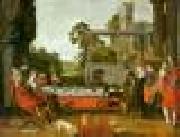 |
BUYTEWECH, Willem
|
|
Dutch Baroque Era Painter, ca.1591-1624
Dutch painter, draughtsman and etcher. Although he was born and died in Rotterdam, stylistically he belongs to the generation of young artists working in Haarlem at the beginning of the 17th century. He was nicknamed 'Geestige Willem' (Dut.: 'inventive, or witty, Willem') by his contemporaries, and during his short career he made an important and highly personal contribution to the new approach to realism in Dutch art. He was one of the first to paint interiors with merry companies
|
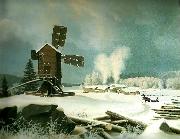 |
broderna von wrights
|
|
Dessa ornitologer, forskare, naturvetenskapliga illustratörer och konstnärer var födda i Haminanlaks nära Kuopio i Finland.
I Stockholm i augusti 1828 påbörjade Magnus och Wilhelm von Wright bildverket Svenska Foglar, finansierat av greve Nils Bonde. Detta ornitologiska verk blev klart 1838 och ar en en samling pa178 litografier.
|
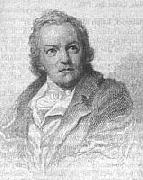 |
Blake, William
|
|
William Blake was an English poet, painter was born November 28, 1757, in London
William Blake started writing poems as a boy, many of them inspired by religious visions. Apprenticed to an engraver as a young man, Blake learned skills that allowed him to put his poems and drawings together on etchings, and he began to publish his own work. Throughout his life he survived on small commissions, never gaining much attention from the London art world. His paintings were rejected by the public |
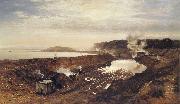 |
Benjamin Williams Leader
|
|
British Painter, 1831-1923
was an English artist. Born in Worcester as Benjamin Leader Williams, he was the son of civil engineer Edward Leader Williams (who was also a keen amateur artist and friend of John Constable) and Quaker Sarah Whiting. His brother, also called Edward Leader Williams, followed in his father's footsteps and became a notable civil engineer. The family lived in Worcester at Diglis House. Williams Leader was educated at the Royal Grammar School Worcester and then the Royal Academy Schools. He immediately became successful as an artist and first exhibited his work at the Royal Academy in 1854. Since that year until his death in 1923 his paintings were hung in every summer exhibition at the Royal Academy. He was knighted as Chevalier of the Legion of Honour by the French in 1889 and was created a full member of the Royal Academy in 1898 (RA - Royal Academician). In 1914 he was given the Freedom of the City of Worcester in recognition of his services (as a director of Royal Worcester Porcerlain and a native of the city). Famous paintings include February Fill Dyke and Autumn's Last Gleam. His paintings were bought by King George V and William Gladstone amongst others, and he became one of the most popular and expensive artists of his day. His works received popular approval for their verisimilitude, and the fame of February Fill Dyke, facilitated by an etching, spread to London, Paris, and the United States. |
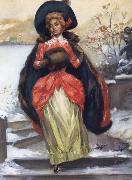 |
Benjamin West Clinedinst
|
|
Illustrator and Painter.
American , 1859-1931
was an American illustrator and painter, born at Woodstock, Va. He studied for a year in Baltimore and for five years in Paris under Cabanel and Bonnat and first attracted attention in New York with his illustrations for Leslie's Weekly. He was best known as the illustrator of Thomas Nelson Page's Unc' Edinburg, the works of Hawthorne, Stevenson, and Mark Twain, although he worked also in oils and water colors. His sympathetic collaboration with the author gave his work an especial charm. He was awarded the Evans prize of the American Water-Color Society in 1900. In 1947. |
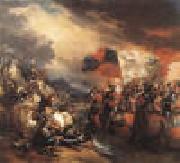 |
Benjamin West
|
|
1738-1820
Benjamin West Locations
Benjamin West RA (October 10, 1738 ?C March 11, 1820) was an Anglo-American painter of historical scenes around and after the time of the American War of Independence. He was the second president of the Royal Academy serving from 1792 to 1805 and 1806 to 1820.
In 1760, sponsored by Smith and William Allen, reputed to be the wealthiest man in Philadelphia, West traveled to Italy where he expanded his repertoire by copying the works of Italian painters such as Titian and Raphael.
As painted by Gilbert Stuart, 1783-84West was a close friend of Benjamin Franklin, whose portrait he painted. Franklin was also the godfather of West's second son, Benjamin.
In 1763, West moved to England, where he was commissioned by King George III to create portraits of members of the royal family. The king himself was twice painted by him. He painted his most famous, and possibly most influential painting, The Death of General Wolfe, in 1770, exhibited at the Royal Academy in 1771. Although originally snubbed by Sir Joshua Reynolds, the famous portrait painter and President of the Royal Academy, and others as over ambitious, the painting became one of the most frequently reproduced images of the period.
In 1772, King George appointed him historical painter to the court at an annual fee of £1,000. With Reynolds, West founded the Royal Academy of Arts in 1768. He was the second president of the Royal Academy from 1792 to 1805. He was re-elected in 1806 and was president until his death in 1820. He was Surveyor of the King's Pictures from 1791 until his death. Many American artists studied under him in London, including Charles Willson Peale, Rembrandt Peale, Gilbert Stuart, John Trumbull, and Thomas Sully. [3]
West is known for his large scale history paintings, which use expressive figures, colours and compositional schemes to help the spectator to identify with the scene represented. West called this "epic representation".
He died in London. |
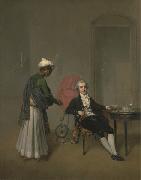 |
Arthur William Devis
|
|
(10 August 1762 - 11 February 1822) was an English painter of history paintings and portraits. He was appointed draughtsman in a voyage projected by the East India Company in 1783, under Captain Henry Wilson, in which he was wrecked on the Pelew Islands before proceeding to Canton and thence to Bengal. He painted portraits and historical subjects, sixty-five of which he exhibited (1779-1821) at the Royal Academy.
|
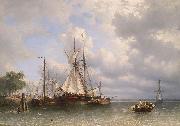 |
Antonie Waldorp
|
|
(The Hague, 28 March, 1803 - Amsterdam, 12 October, 1866) was a Dutch painter and a forerunner of the Hague School.
Anthonie Waldorp was the son of Abel de Saaijer Waldorp and Jacomina Godde, and the grandson of Jan Gerard Waldor, who was superintendent of the National Art Gallery. On February 25, 1824 he married Johanna Sophia Waldorp van Hove. At the wedding in The Hague there was a clerical error in the marital attachments, mistakenly registering Anthonie as Anthonie Waldorp instead of Saaijer Waldorp.
Shortly after his 23rd birthday, Anthonie decides to follow a career as a painter and became one of the precursors of the Hague School. Anthonie took an apprenticeship with the well known stage scenery painter Joannes Breckenheimer jr. (1772-1856) in The Hague, who was also the tutor of the well known painter Andreas Schelfhout.
Anthonie started painting stage sceneries like his grandfather. Later he focused on domestic and church interiors and portraits (people in 17th century costumes). Finally he specialized in landscapes, river and seascapes (paintings, drawings and water colors). It proved to be a wise decision as it led to international recognition. He also did some lithographic work. In 1833, together with Wijnand Nuyen, he traveled through France, Belgium and Germany and became the tutor of C.P. et Hoen, J.C. Hofman, C. Rochussen and Johan Hendrik Weissenbruch. Many of his paintings were bought by German, Dutch and French kings.
Until 1857 he lived in The Hague, after which he settled in Amsterdam where he joined the Royal Academy . He received several awards: in 1845 Waldorp was appointed Knight of the Order of Leopold by the Belgian king, Knight in the Order of the Dutch Lion in 1847 by King William II and Knight in the Order of the Oak Crown in 1849 by William.
In The Hague and Amsterdam there are streets named after Anthonie Waldorp.
|
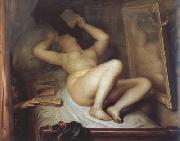 |
Antoine Wiertz
|
|
Belgian Painter, 1806-1865
Belgian painter and sculptor. He was from very humble origins, but his talent for drawing was detected at an early age. He was sent to the Antwerp Academie, where he attended classes given by W. J. Herreyns (1743-1827) and Mathieu Ignace Van Br?e. During a stay in Paris from 1829 to 1832 he came into contact with the Romantic painters, in particular Th?odore G?ricault, who fostered his admiration for Rubens. In 1832 he won the Belgian Prix de Rome and in 1834 left for Italy where the works of Raphael and, above all, Michelangelo made an overwhelming impression on him. In Rome he abandoned the landscapes and scenes from Roman life, for which he showed a certain talent, and embarked on a much more ambitious work, the Greeks and the Trojans Contesting the Body of Patroclus (1835; Brussels, Mus. Wiertz.). The painting proved the turning-point in Wiertz's career. Its frenzied composition and violently contorted figures excited considerable interest in Rome. |
 |
Anna Waser
|
|
Anna Waser (1678 - 1714) was a Swiss painter . |
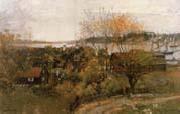 |
Alfred Wahlberg
|
|
1834-1906,Swedish painter. He received some tuition in drawing at the Royal Academy of Arts in Stockholm, although he was never formally enrolled as a student. In 1857 he went to D?sseldorf where he was a student of Hans Fredrik Gude. Swedish Landscape, Kolm?rden (1866; Stockholm, Nmus.) is representative of Wahlberg's D?sseldorf period. After a journey to the Netherlands and Belgium he returned to Stockholm in 1862 and became a member of the circle of artists around Karl XV. |
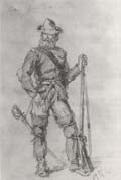 |
Alfred R. Waud
|
|
American, 1828-1891,was an American artist and illustrator, born in London, England. He is most notable for the sketches he made as an artist correspondent during the American Civil War. Before emigration, Alfred Waud had entered the Government School of Design at Somerset House, London, with the intention of becoming a marine painter. This did not come to fruition, but as a student, he also worked as a painter of theatrical scenery. He intended to pursue that work in the United States, when he immigrated in 1850, seeking employment with actor and playwright John Brougham. In the 1850s, he worked variously as an illustrator for a Boston periodical, the Carpet-Bag, and provided illustrations for books such as Hunter's Panoramic Guide from Niagara to Quebec (1857). The period during the American Civil War was time when all images in a publication had to be hand drawn and engraved by skilled artist. Photography existed but there was no way to transfer a photograph to a printing plate since this was well before the advent of the halftone process for printing photographs. Photographic equipment was too cumbersome and exposure times were to slow to be used on the battlefield. An artist such as Waud would do detailed sketches in the field, which were then rushed by courier back to the main office of the newspaper they were working for. There a staff of engravers would use the to sketches create finished engravings for publication. In 1860 Alfred Waud became an illustrator or special artist (a full time paid staff artist) for the New York Illustrated News. In April 1861, the newspaper assigned Waud to cover the Army of the Potomac, Virginia main Union army. He first illustrated General Winfield Scott in Washington, D.C., and then entered the field to render the First Battle of Bull Run in July. Waud followed a Union expedition to Cape Hatteras, North Carolina the next month. That autumn, he sketched army activity in the Tidewater region of Virginia. Waud joined Harper's Weekly toward the end of 1861, continuing to cover the war. In 1864 Alfred brother, William Waud (who up to that time had been working with Frank Leslie Illustrated Newspaper), joined Alfred on the staff of Harper's and they worked together during the Petersburg Campaign. Alfred Waud attended every battle of the Army of the Potomac between the First Battle of Bull Run in 1861 and the Siege of Petersburg in 1865. Alfred was one of only two artists present at the Battle of Gettysburg. His depiction of Pickett Charge is thought to be the only visual account by an eyewitness. Waud died in 1891 in Marietta, Georgia, while touring battlefields of the South. |
 |
alexis wetterbergh
|
|
wetterberghs malning bar professor sandbergs godkannande paskrift, men eftersom maleri inte forekom pa konstakademiens schema fore 1856 |
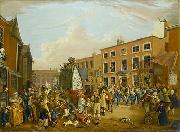 |
Alexander Wilson
|
|
Alexander Wilson (July 6, 1766 - August 23, 1813) was a Scottish-American poet, ornithologist, naturalist, and illustrator.
Wilson was born in Paisley, Scotland, the son of an illiterate distiller. In 1779 he was apprenticed as a weaver. His main interest at this time was in writing poetry (Robert Burns was seven years older than Wilson). Some of Wilson's work - commenting on the unfair treatment of the weavers by their employers - got him into trouble with the authorities. The "golden age of Renfrewshire song" is embodied in the persons of Wilson and Robert Tannahill. Alexander Wilson was born near the Hammils, a broad if not steep waterfall in Paisley where the River Cart skirts Seedhill. It does indeed appear to be the case, as William Motherwell states, that a great amount of literary activity began in Paisley around this time.
Illustration from
"An American ornithologyIn May 1794 Wilson left Scotland with his nephew to find a better life in America. Wilson obtained employment as a schoolteacher in Milestown, near Philadelphia. In 1801 he left Milestown and found a new teaching post in Gray's Ferry, Pennsylvania; Wilson took up residence in nearby Kingsessing. It was here that he met the famous naturalist William Bartram who developed Wilson's interest in ornithology. In 1802 Wilson decided to publish a book illustrating all the North American birds. With this in mind he traveled widely, watching and painting birds and collecting subscribers for his book. The result was the nine-volume American Ornithology (1808-1814), illustrating 268 species of birds, 26 of which had not previously been described. He died during the writing of the ninth volume, which was completed and published after his death by his friend George Ord. Wilson lies buried next to Ord at Gloria Dei Church cemetery in Philadelphia, Pennsylvania. |
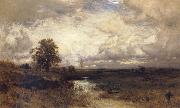 |
Alexander Helwig Wyant
|
|
American Tonalist Painter, 1836-1892,American painter. He began as an itinerant painter of topographical landscapes along the banks of the Ohio River c. 1854, influenced by such landscape artists as Worthington Whittredge and George Inness. In 1863-4 Wyant moved to New York, where he was impressed by the paintings of the Norwegian artist Hans Gude in the Desseldorf Gallery. This led him to work with Gude in Karlsruhe, Germany, in 1865. On his way both there and back, he studied paintings by Constable and used a more painterly technique especially for views of Ireland. |
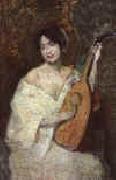 |
Alden J Weir
|
|
1852-1919
Painter, printmaker and teacher, son of (1) Robert Walter Weir. His art education began in the studio of his father. There he and his half-brother (2) John Ferguson Weir acquired an appreciation for the Old Masters, particularly of the Italian Renaissance and of the 17th-century Dutch schools. While Weir pursued in his art a course very different from that of his father and half-brother, his personality as well as his artistic attitudes were shaped by them. In the winters of 1870-71 and 1871-2, he continued his studies at the National Academy of Design in New York, where his instructor was Lemuel Wilmarth (1835-1918).
|
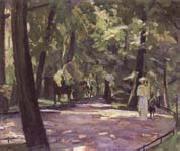 |
Albert Weisgerber
|
|
German, 1878-1915
German painter and printmaker. He studied decoration at the Kreisbaugewerksschule in Kaiserlautern (1891-3) and began work in a decorator studio in Frankfurt am Main. However, in 1894 he moved to Munich to resume his studies, first at the Kunstgewerbeschule and later under Franz von Stuck at the Akademie der Bildenden Kenste (1897-1901). For some years he concentrated on poster design and book illustration, contributing a total of 500 drawings to Jungend: Illustrierte Wochenschrift for Kunst und Leben from 1899. His early paintings such as the portrait of Ludwig Scharf II (c. 1905; Munich, Staatsgal. Mod. Kst) were executed in dark-toned academic style, but an exhibition of French Impressionism in Berlin in 1905 so impressed him that he went to Paris for nearly a year (until May 1906). Despite his association with the circle of artists around Matisse, he was more influenced by the work of Cezanne. In 1907 he made a second visit to Paris and joined Phalanx in 1909. In the latter year he was visited by Hans Purrmann and Matisse. By 1911 with a third visit to Paris and travels to Rome and Naples, he had established himself as one of the foremost German Impressionists. As well as such lyrical scenes as Munich Hofgarten (1911; Munich, Lenbachhaus), in common with many of his German contemporaries, Weisgerber reconceived classical scenes in an energetic style, for example in Amazon Camp (1910; Stuttgart, Staatsgal.). In 1912 he had a one-man show in the Kunsthaus, Zurich, and a year later participated in the annual Kunstausstellung in Munich. Although using an Impressionist style, he was equally at home in Expressionist circles, and this undoubtedly influenced his election to the presidency of the Neuen Menchner Sezession (1913). In the last four years of his career he was obsessed with sacrificial subject-matter from the Old and New Testaments, which he had originated in the theme of St Sebastian (e.g. St Sebastian Felled by Arrows, 1910; Munich, Staatsgal. Mod. Kst). While not exclusively tragic (e.g. David and Goliath, 1914; Saarbrecken, Saarland-Mus.), these final works strip away historical references to concentrate upon the fate of the isolated individual, as in Absalom (1914; Hamburg, Ksthalle). |
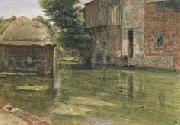 |
Albert Goodwin,RWS
|
|
1845-1932
English painter. During the early 1860s Goodwin studied with Arthur Hughes and Ford Madox Brown, who predicted that his pupil would become 'one of the greatest landscape painters of the age'. Hughes and Brown impressed on Goodwin the Pre-Raphaelite principles of high finish, vivid colour and working directly from nature that inform his early landscape style |
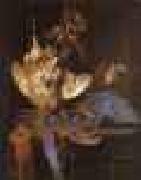 |
Aelst, Willem van
|
|
Dutch Baroque Era Painter, 1627-ca.1683 Studied under Otto Marseus van Schrieck. Students included Rachel Ruysch. Specializes in Still Life. was a Dutch artist who specialized in still-life painting with flowers or game. Van Aelst was born to a family of prominent city magistrates. He learned to paint from his uncle, the still-life painter Evert van Aelst. On 9 November 1643 he enrolled as a master of the Guild of Saint Luke at Delft. Between 1645 and 1649 he lived in France. In 1649 Van Aelst travelled to Florence, where he served as court painter to Ferdinand II de Medici, grand duke of Tuscany. At this time, the grand duke also employed two fellow Dutchmen Matthias Withoos and Otto Marseus van Schrieck, the latter also a still-life painter who probably influenced Van Aelst's style. In 1656 he returned to the Netherlands to settle permanently in Amsterdam. He became one of the most prominent still-life painters of his generation, |
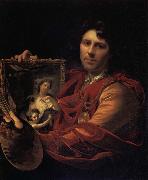 |
Adriaen van der werff
|
|
Dutch Baroque Era Painter, 1659-1722
Dutch painter and draughtsman. He was apprenticed to the portrait painter Cornelis Picolet (1626-79) from 1668 to 1670 and then from c.1671 to 1676 to Eglon van der Neer in Rotterdam. From 1676 van der Werff produced small portraits and genre paintings as an independent master; the Cook and Hunter at a Window (1678; New York, priv. col.; see Gaethgens, no. 2) and Man and Woman Seated at a Table (1678; St Petersburg, Hermitage) perpetuate the thematic and stylistic traditions of Gerrit Dou, Gabriel Metsu, Frans van Mieris and Gerard ter Borch (ii) but are distinguished by their greater elegance and richness of costume and interior. Van der Werff's portraits date mainly from the years 1680-95 (e.g. Two Children with a Guinea-pig and a Kitten (1681; London, Buckingham Pal., Royal Col.)). The motif of children with animals recalls van der Neer, while the careful depiction of fabrics recalls the Leiden school of 'Fine' painters. His Portrait of a Man in a Quilted Gown (1685; London, N.G.) resembles compositions by Caspar Netscher and Nicolaes Maes: a figure leaning against a balustrade, before a landscape. Van der Werff's work is, however, more elegant, in part because of the depiction of fabrics |
|

